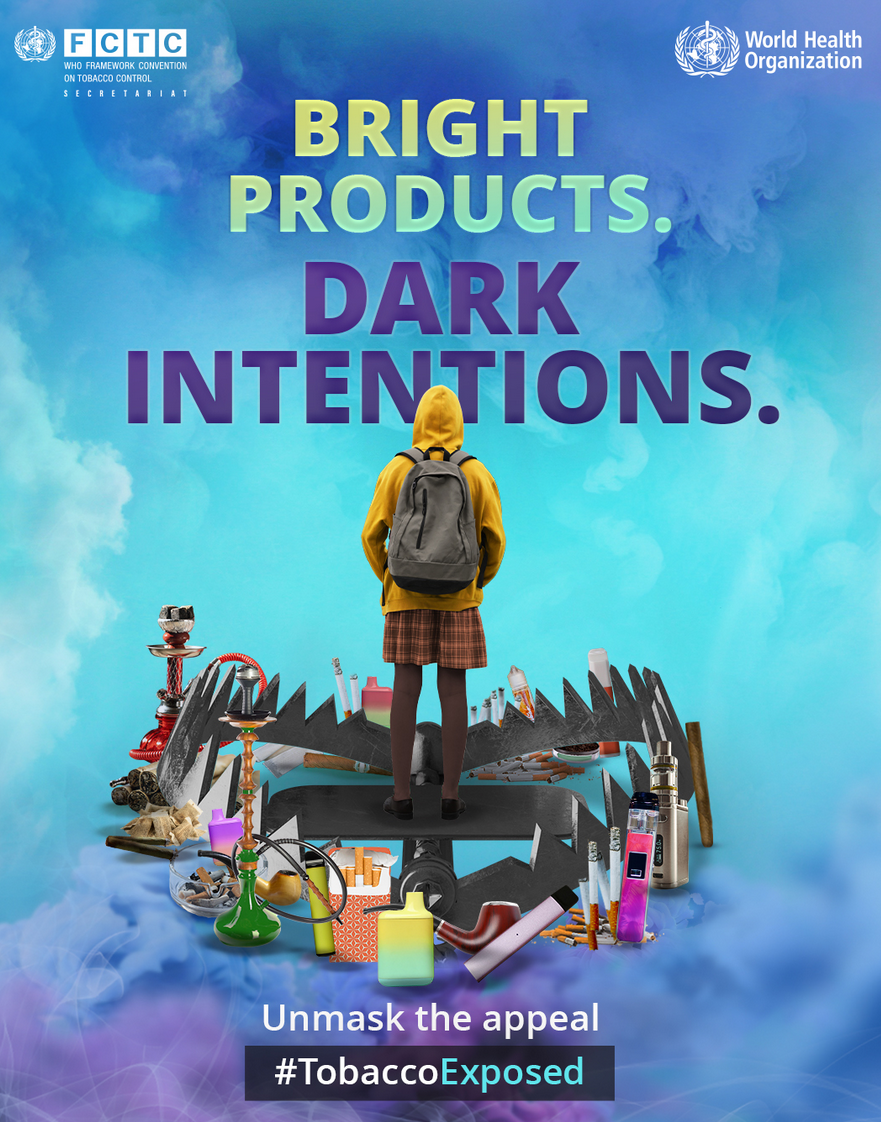As the world observes World No Tobacco Day, the Secretariat of the WHO FCTC is issuing a call to prohibit and ban the ingredients used to increase product attractiveness and palatability like sweeteners and flavours. These products are designed to lure children and young people into addiction, putting at risk their health and future.
The theme of this year's World No Tobacco Day, "Unmasking the Appeal: Exposing Industry Tactics on Tobacco and Nicotine Products," highlights the growing recognition that new nicotine products are not benign or healthier alternatives but are engineered to addict and specifically attract youth.
"The tobacco and nicotine industries have a long and troubling history of aggressively marketing harmful products, especially to children and young people," said Dr Adriana Blanco Marquizo, Head of the Secretariat of the WHO FCTC.
"These industries prey on youth, luring them into addiction with sweet flavours, flashy packaging, and misleading messaging. These tactics may increase profits, but they do so at a devastating cost to human health — and we must act urgently and decisively to stop them."
Tobacco use kills millions annually, and the proliferation of new nicotine products presents fresh threats, particularly for young people who are being exposed to addiction in insidious new ways.
One of the most effective and dangerous tactics employed by the industry is the use of flavours. From menthol to mango, these flavours attract new nicotine users, particularly adolescents, and mask the harshness of tobacco, making it easier to start and continue using these products and contributing to both initiation and long-term use.
As early as 2010, Parties to the WHO FCTCrecognized these serious risks, recommending the prohibition or restriction of ingredients that increase product attractiveness and palatability, such as sweeteners and flavors.
More than 50 countries have banned flavoured tobacco products. However, despite progress, Parties to the Convention still face challenges in fully implementing measures and progress remains uneven across countries, particularly regarding banning or regulating the addition of flavours to products.
The WHO FCTC, the first ever public health treaty negotiated under the auspices of WHO, provides a legally binding treaty on tobacco control. Key articles in this regard include:
- Article 9 (Regulation of contents): Empowers governments to regulate ingredients, including flavors, that increase palatability and addictiveness.
- Article 10 (Product disclosures): Mandates full disclosure of ingredients, promoting transparency and aiding enforcement.
- Article 13 (Advertising, promotion, and sponsorship): Requires comprehensive bans on advertising, including on digital platforms and entertainment media.
- Article 16 (Sales to and by minors): Mandates restrictions on youth access, including age limits and banning sales near schools.
Regulation alone is insufficient. Implementation of Article 5.3 of the Convention, addressing industry interference, is crucial. That provision and its Guidelines for implementation require Parties to protect public health policies from the commercial interests of the tobacco industry, urging rejection of partnerships, resistance to lobbying, and keeping decision-making spaces free from industry influence.
Parties are further urged to:
- Ban flavours in all products, including post-sale flavour accessories.
- Insist on plain packaging and limit youth-attractive product design elements.
- Enforce advertising bans extending to social media, influencer marketing, and entertainment.
- Ensure tobacco- and nicotine-free public places to protect non-users and de-normalize product use.
- Strengthen enforcement of age restrictions and regulate online sales and delivery.
"This issue goes beyond public policy — it is about protecting our children, our families, and our communities from products that are designed to addict and kill," added Dr Blanco Marquizo.
"The industry’s tactics may be evolving, but our resolve must remain firm. The WHO FCTC and the decisions of its Governing Body offer a roadmap. It empowers us with the tools to unmask the tobacco industry’s appeal, shut down its tactics, and prioritize health over profit. But it will take all of us — governments, policy-makers, advocates, parents, and youth — to make this vision a reality. We must act now.”
Notes to editors
The WHO FCTC is the first ever public health treaty negotiated under the auspices of WHO with 183 Parties to the Convention covering 90% of the global population. The treaty provides a legal framework and a comprehensive package of evidence-based tobacco control measures underpinned by international law that have saved millions of lives including large pictorial health warnings on cigarette packages, smoke free laws and increased taxes on tobacco products, among many others.
This yearly celebration of World No Tobacco Day informs the public on the dangers of using tobacco, the business practices of tobacco companies, what WHO is doing to fight the tobacco epidemic, and what people around the world can do to claim their right to health and healthy living and to protect future generations.
The Member States of the World Health Organization created World No Tobacco Day in 1987 to draw global attention to the tobacco epidemic and the preventable death and disease it causes. In 1987, the World Health Assembly passed Resolution WHA40.38, calling for 7 April 1988 to be a "a world no-smoking day." In 1988, Resolution WHA42.19 was passed, calling for the celebration of World No Tobacco Day, every year on 31 May.
